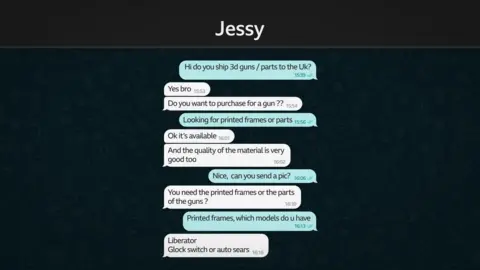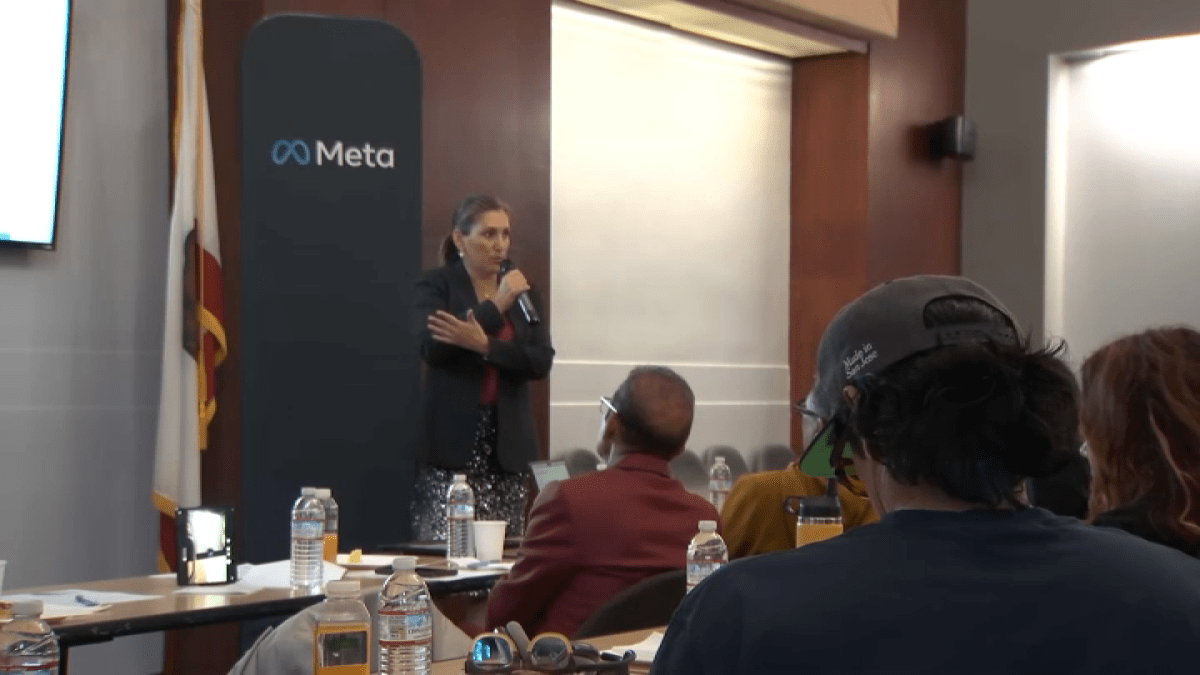AI Insights
How 3D-printed guns are spreading online

 Getty/BBC
Getty/BBC3D-printed guns could become “the weapon of choice” for criminals and violent extremists around the world, an expert has told the BBC. These DIY, untraceable firearms have been recovered in several recent criminal cases, including the alleged use of a partially 3D-printed gun in the killing of United Healthcare CEO Brian Thompson.
BBC Trending has investigated the global spread of 3D-printed guns across social media platforms including Telegram, Facebook and Instagram, as well as websites offering how-to guides.
3D-printed guns, often described as a type of “ghost” gun, are untraceable firearms that can be assembled using a 3D printer, downloadable blueprints and some basic materials. Designed to evade gun-control laws, the technology has advanced rapidly in the last decade, with the latest models capable of firing multiple rounds without their plastic components breaking.
According to Nick Suplina of Everytown, a US-based gun control organisation, 3D-printed guns could become the “weapon of choice” for people planning acts of violence: “The materials have gotten better, the cost has gone down, and the ease of access of these blueprints is at a high,” he said.
BBC Trending’s investigation began with advertisements for guns on Instagram and Facebook. In October 2024, the Tech Transparency Project, a non-profit that monitors technology companies, found hundreds of gun ads – including for 3D-printed and other ghost guns – appearing on Meta’s platforms, in violation of its policies.
Meta declined to comment on the findings at the time. Several months later, BBC Trending found similar gun adverts still showing as active in Meta’s ad database.
 Meta/BBC
Meta/BBCMany of these gun adverts directed potential customers to Telegram or WhatsApp channels. On Telegram, we found channels displaying a variety of guns for sale. Some of these appeared to be 3D-printed. One Telegram account with over 1,000 subscribers claimed to ship weapons globally.
BBC Trending contacted the account, which called itself “Jessy”, to confirm whether it would be willing to break the law by shipping 3D-printed guns to the UK. Within an hour, Jessy offered us a Liberator or a Glock switch.

A glock switch (also known as an auto sear) is a small, sometimes 3D-printed part that converts a pistol into an automatic weapon.
The Liberator, designed in 2013 by “crypto-anarchist” Cody Wilson, is the world’s first widely available 3D-printed gun, capable of firing a single shot.
Jessy claimed he could smuggle the weapon through UK customs, asked for payment of £160 in bitcoin, then suggested a bank transfer to a UK account we couldn’t trace.
When we later contacted Jessy, identifying ourselves as the BBC, he acknowledged that selling weapons in the UK is illegal but sounded unapologetic.
“I run my business, sell some straps [slang for weapons] online,” he said.
We did not proceed with the transaction to test Jessy’s claims. While his casual attitude suggested he might have been a scammer, his ability to advertise on Meta and operate on Telegram highlights apparent loopholes that real gun dealers could exploit.
When contacted, Meta told the BBC that the adverts we highlighted had been “automatically disabled in line with our policies”, and that inclusion in its ad library “doesn’t necessarily mean the ad is still live or visible”.
Telegram said that Jessy’s account had been proactively removed for breaching its policies. A spokesperson added: “The sale of weapons is explicitly forbidden by Telegram’s terms of service and is removed whenever discovered. Moderators empowered with custom AI and machine learning tools proactively monitor public parts of the platform and accept reports in order to remove millions of pieces of harmful content each day, including the sale of weapons.”
Concerningly though, people seeking 3D-printed guns don’t need to buy readymade ones through social media. They can assemble their own. Models like the FGC-9 are designed using only 3D-printed plastic and repurposed metal components, with no commercially available gun parts required.
“You are essentially becoming a DIY gunsmith,” says Dr Rajan Basra, a researcher at King’s College London. However, “It’s not as easy as printing off a sheet of A4 paper in your office printer.”
As the BBC has previously reported, there are websites offering free step-by-step guides and downloadable blueprints for building 3D-printed guns.
One such guide was written by Matthew Larosiere, a gun rights attorney in Florida. He’s associated with the global pro-3D-printed gun community, which has many members in the USA who see the Second Amendment right to bear arms as a human right.
BBC Trending challenged him about why he is sharing information to help people build a lethal weapon.
He replied: “It’s just information. It’s ones and zeros. The fact that the information has a use case that makes you uncomfortable, I understand and I sympathise with that, but that doesn’t make it correct to say it’s anything more than information.”
Asked about the risk of this “information” being used in a school shooting or massacre, he replied: “I thank God that has not happened.” He cited Myanmar as a country where, in his view, 3D-printed guns have served a positive cause.
 Getty
GettyMyanmar is currently the only known case of 3D-printed guns being used in active military conflict. The FGC-9’s use by resistance fighters against the junta has been widely reported.
But as BBC Burmese’s Hnin Mo discovered, many of these groups have since stopped using 3D-printed guns. This is despite resistance forces producing hundreds of FGC-9s in 2022 and 2023, which cost over ten times less than machine guns on the black market.
The rebel leaders Hnin Mo spoke to cited the junta’s tight control over imports of essential materials like glue and metal. Additionally, these groups now have more conventional weapons at their disposal, such as RPGs or machine guns.
The Myanmar example demonstrates the limitations of current 3D-printed guns for military use. But globally, their spread is clear. Several countries are considering laws to criminalise the possession of blueprints. There are also calls for 3D printer manufacturers to block the printing of gun parts, in the same way that conventional printers restrict the printing of currency. But whether such measures can be effective remains to be seen.
Additional reporting by Hnin Mo, BBC Burmese
AI Insights
Oakland Ballers to use artificial intelligence to manage Saturday home game against Great Falls

OAKLAND, Calif. (AP) — Oakland Ballers manager Aaron Miles will leave it to artificial intelligence to decide when to pinch hit or replace his pitcher.
The playoff-bound Ballers of the independent Pioneer League are turning to AI to manage most aspects of Saturday’s home game against the Great Falls Voyagers at Raimondi Park. So it might feel almost like a day off for the skipper, whose lineup and in-game decisions will even be made for him — from a tablet he will have in the dugout providing instructions.
Advertisement
The starting pitcher is already set.
“Luckily it’s only game. Maybe we’ve done so well that the AI will just keep doing what we’re doing,” Miles joked Wednesday. “Being a 70-win team we’ve got a very good bench. It’s hard to write a lineup without leaving somebody out that’s really good. This game I’ll be like, ‘Hey, it’s not on me for not writing you in there, it’s on the computer.’ It won’t be my fault if somebody’s not in the lineup, I guess I’ll enjoy that.”
Yet Miles knows he still might have to step in with some lineup adjustments, because the human element still matters when it comes to someone who could need rest or take a break because of injury or other circumstances.
Co—founder Paul Freedman said the second-year club will produce the first AI-powered professional sporting event. It happens to be Fan Appreciation day, too.
Advertisement
Last year, during the Ballers’ inaugural season, they had a game in which fans wrote the lineup and chose the uniforms — but Oakland lost. So the Ballers are doing it differently this time by partnering with AI company Distillery to control almost everything.
“The AI won’t be able to do third-base coaching, we don’t have the technology for that yet,” Freedman said. “The human will be responsible for waving somebody home or throwing up the hand. But those kind of situational decisions, we will look to the machine to make the call.”
Freedman figures with the Ballers having locked up the top seed for playoffs, this is a perfect opportunity to give AI a try.
And no need for Miles to be concerned with job security, even with the greater potential for Monday-morning quarterbacking when it comes to his moves.
Advertisement
“The good news is Aaron has won 100 games for us and right now our winning percentage is well over 75%, I think his job is pretty safe,” Freedman said. “And we’re happy with the decisions he’s made, but we do think it’s cool. One of the fun things about being a sports fan is being able to engage in conversations after the game about the key decisions. So this is a breadcrumb for us for what we think could be something if it works well could be part of a fan experience application or something that we do where after a game we kind of highlight what the key decisions were that our manager made and which ones kind of went against the grain — either for right or wrong.”
Miles has already experimented with AI a couple of times but earlier this season one roster showed up as the 2024 group. He expects AI might end up making a smarter decision just based on real-time data.
“I fooled around with this before just for fun, now it’s for real,” he said, “for one game.”
Ballers catcher Tyler Lozano is open-minded to incorporating new elements into the game to complement the analytics — as long as the treasured traditions aren’t lost.
Advertisement
“It’s immersive, it’s definitely involving new technology, new everything. It’s interesting to see what an AI platform or AI software can do for a baseball team,” Lozano said. “There’s always going to be a human element in the game of baseball. I think in sports period there’s going to be some type of human element because you’re live, you’re there. These AI platforms aren’t watching the game or don’t see all of the intricate moments that happen throughout the game and the human element of the player. I don’t think you’re going to lose that.”
___
AP MLB: https://apnews.com/hub/mlb
AI Insights
Oakland Ballers to use artificial intelligence to manage Saturday home game against Great Falls – Bluefield Daily Telegraph
AI Insights
AI creates fear, intrigue for Bay Area small businesses – NBC Bay Area

Companies in the Bay Area are both embracing and increasingly fearful of artificial intelligence.
On Wednesday, Meta, one of the world’s biggest tech companies, got together with some small businesses at the San Jose Chamber of Commerce to talk about how the machines can help.
For many small businesses, AI has been something they just don’t yet have time for, but they say they’re curious.
“I think small businesses start with confusion,” San Jose Chamber of Commerce CEO Leah Toeniskoetter said. “What is it? It means so many things. It’s too big of a word. It’s like the web or like the internet. So it starts with let’s offer a course like this, an opportunity like this, to share what AI is in relation to your business.”
Meta said discussions like Wednesday’s, which brought in about 30 owners, help bridge the gap between big tech and small business.
“So getting them to adopt and use AI, even in small ways right now, is a great step forward to keep them engaged as AI is really transforming our economy,” said Jim Cullinan with Meta.
-

 Business5 days ago
Business5 days agoThe Guardian view on Trump and the Fed: independence is no substitute for accountability | Editorial
-
Tools & Platforms3 weeks ago
Building Trust in Military AI Starts with Opening the Black Box – War on the Rocks
-

 Ethics & Policy1 month ago
Ethics & Policy1 month agoSDAIA Supports Saudi Arabia’s Leadership in Shaping Global AI Ethics, Policy, and Research – وكالة الأنباء السعودية
-

 Events & Conferences4 months ago
Events & Conferences4 months agoJourney to 1000 models: Scaling Instagram’s recommendation system
-

 Jobs & Careers2 months ago
Jobs & Careers2 months agoMumbai-based Perplexity Alternative Has 60k+ Users Without Funding
-

 Education2 months ago
Education2 months agoVEX Robotics launches AI-powered classroom robotics system
-

 Funding & Business2 months ago
Funding & Business2 months agoKayak and Expedia race to build AI travel agents that turn social posts into itineraries
-

 Podcasts & Talks2 months ago
Podcasts & Talks2 months agoHappy 4th of July! 🎆 Made with Veo 3 in Gemini
-

 Podcasts & Talks2 months ago
Podcasts & Talks2 months agoOpenAI 🤝 @teamganassi
-

 Education2 months ago
Education2 months agoAERDF highlights the latest PreK-12 discoveries and inventions



